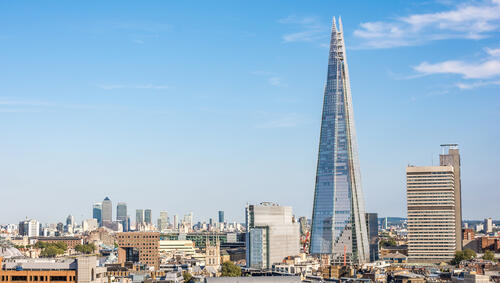Residential, commercial, or industrial, we love it when architects go to town with an original design. Whether they build something quirky, unique, or just plain funky, witnessing their creative vision brought to life is one of the reasons we love to travel. Here are our picks for the 15 coolest buildings from around the world.
Bosco Verticale, Milan
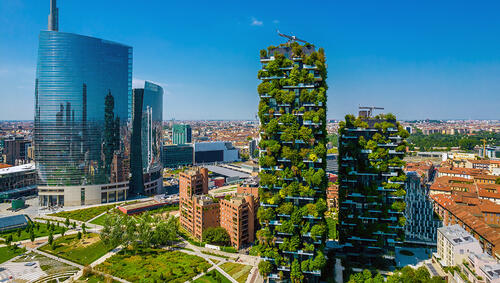
Sustainability is an increasingly important factor in today’s world. In Milan, it’s hoped that the groundbreaking Bosco Verticale (Vertical Forest) will become a template for similar projects. Located in the Porta Nuova area of the city, the award-winning site comprises two towers, each with staggered balconies. Around 800 trees are incorporated into their façades, alongside 5,000 shrubs and countless perennials. This green cloak helps to regulate the blocks’ microclimate filtering the sun’s rays, producing oxygen, and absorbing carbon dioxide in the process. The vegetation changes with the seasons, making this a dynamic architectural environment that begs to be visited multiple times.
Guggenheim Museum, Bilbao
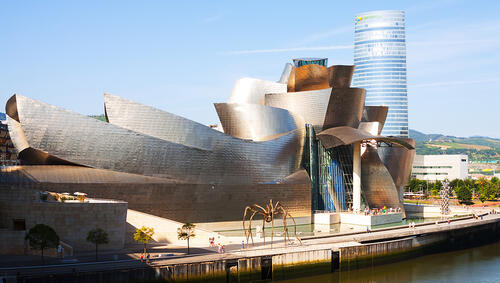
Spain's grittiest northern industrial town upped the glam factor when it welcomed the Guggenheim to the banks of the Nervion River. This Frank Gehry classic was inaugurated in 1997 and has been a favorite with locals and visitors ever since. Inside, you'll discover modern and contemporary art, but it's the external design that wows visitors. Its random, titanium-clad curves catch the light, leading the New York Times Magazine to praise its "mercurial brilliance." Various sculptures have been placed around the building, itself a work of art. Arachnophobes beware: one of them is Louise Bourgeois’ magnificent Maman – a bronze, marble and stainless steel spider that stands more than 30 feet tall.
The Chapel of the Holy Cross, Sedona

Striking in its simplicity and making use of its gorgeous natural setting, this church in Sedona is a staple of the American West. The Catholic church rises out of the red rock face, its stained-glass windows glittering in northern Arizona's near-constant sunshine. The idea came about in the 1930s when local rancher Marguerite Brunswig Staude, inspired by the Empire State Building, commissioned a project to be built in Hungary. The project ran into difficulties – not least the outbreak of WWII – so it relocated to Arizona. Completed in 1956, the church has become a growing attraction in an area already characterized by gorgeous scenery.
Dancing House, Prague
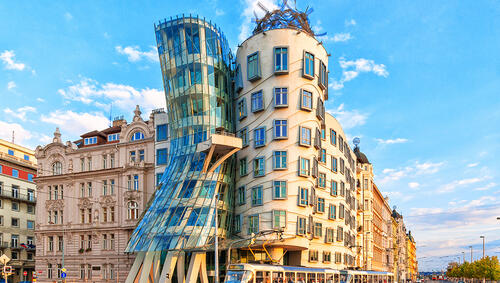
The distinctive shape of the Dancing House makes it one of Prague’s most recognizable buildings. The result of a collaboration between Croatian architect Vlado Milunić and acclaimed Canadian-American Frank Gehry, it occupied a prominent gap where an apartment building had been bombed during WWII. The design needed to be something special. First nicknamed Fred and Ginger after the famous dancing duo, it polarized opinion in the city. The then-president Havel loved it, but some of Prague's residents felt it was incongruous against the city's many Baroque and Gothic structures. Love it or hate it, you have to agree the Dancing House makes quite a statement.
The Oculus at the World Trade Center, New York

The Oculus is designed to resemble a phoenix in mid-flight. This powerful symbolism was as intentional as it is dramatic, as Santiago Calatrava’s brief was made more complex by its location, close to the 9/11 Memorial and Museum. The building, a transport hub, had to show sensitivity to the area’s recent past while creating a functional space for Manhattan commuters. The finished structure, built from glass, steel, stone and concrete, houses the World Trade Center PATH station, numerous subway lines and a plethora of retail, dining and office spaces. On September 11 each year, the sun aligns to send a shaft of light down through the atrium from 8:46 am, when the first plane hit, until 10:28 am, when the second tower collapsed.
Mezquita, Córdoba

Proving that a building doesn't have to be new to be cool, Córdoba's Mezquita is a treat for the eyes. This UNESCO World Heritage Site is one of the finest examples of Islamic architecture anywhere in the world. Hundreds of repeated arches create the illusion of space even when tourists crowd its cavernous interior. Originally a mosque, it was converted to a cathedral in 1236. Christian worshippers originally used it in its unaltered state, but during the reign of King Carlos I in the 16th century, an altar was inserted which was later fitted with a jasper and red marble retable. The mahogany choir stalls date from the 18th century.
Kubuswoningen, Rotterdam
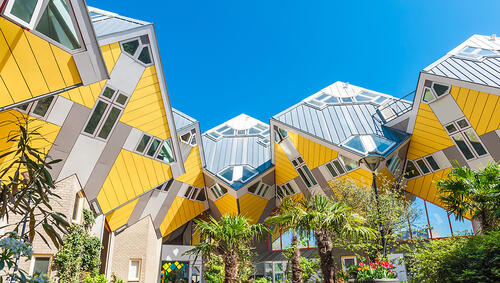
Rotterdam’s Cube Houses are the work of Dutch architect Piet Blom. His cluster of tilted yellow boxes was designed to look like a forest of urban treehouses but he said he took some of his inspiration from Florence’s 14th century Ponte Vecchio. Some of the complex is residential, but visit the Kijk-Kubus Museum-house if you would like to step inside one and admire its quirky features and awkward angles from within. The larger cubes have been turned into a cool tourist hostel, so it’s also possible to spend the night – choosing a regular hotel room just doesn’t stack up in this trendy city.
The Shard, London
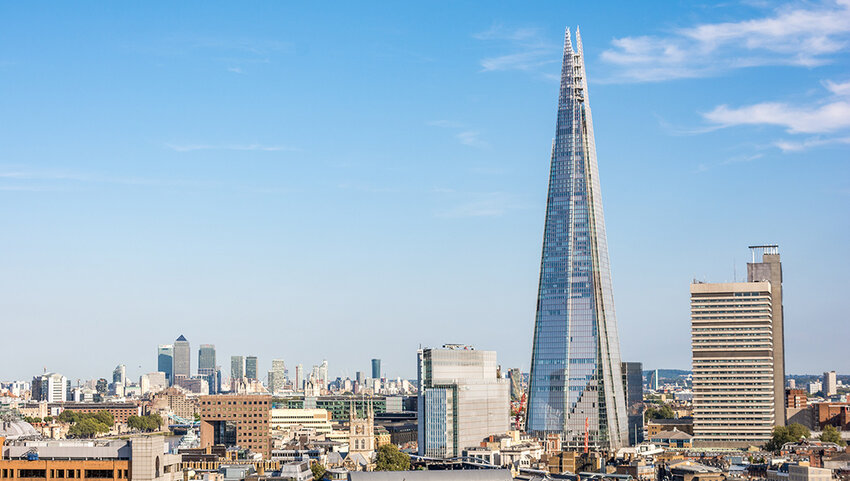
For many years, London remained a low-rise city, but in recent decades, a clutch of shiny skyscrapers has sprung up from its historic streets. At 306 meters, the Shard, near London Bridge, is the tallest, its spire often cocooned in mist or cloud, adding an ethereal quality to the design. Renzo Piano’s spindly structure is home to a collection of offices, restaurants, and the luxurious Shangri-La Hotel, functioning as a vertical city. From its observation deck, visitors have a bird’s eye view of the rail tracks of London Bridge station and the vessels that ply the silvery River Thames. Unsurprisingly, the Shard has quickly become a fixture of the London skyline.
Bird's Nest Stadium, Beijing

Officially called the National Stadium, the latticework of this Beijing sporting venue gave it the nickname "Bird's Nest." The saddle-shaped exterior shell is the world’s largest steel structure. Designed by Herzog & de Meuron, it employed Chinese artist Ai Weiwei as artistic consultant, bringing to life a grand vision. The earthquake-proof stadium opened for the 2008 Summer Olympics, and has mostly remained a tourist destination. However, it was reused for the opening and closing ceremonies of the 2022 Winter Games.
Silo Hotel, Cape Town
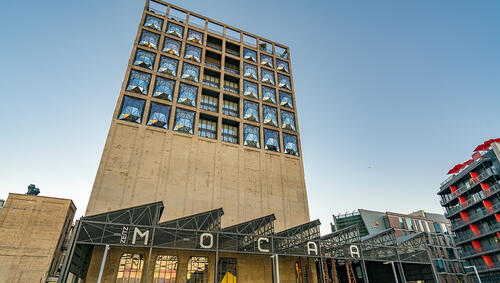
Converted from a grain silo, this extraordinary structure is one of Cape Town's most admired buildings and a fabulously stylish luxury hotel. You’ll need deep pockets to stay here but it’s worth the splurge. Located in the V&A Waterfront, there are great views whichever direction you face – it overlooks Table Bay and Table Mountain. The impactful rooms have been designed to allow the bulging, bug-eyed windows to take center stage. Meanwhile engineers hollowed out the interior to form a breathtaking atrium that houses the Zeitz MOCAA contemporary art gallery.
Lotus Temple, New Delhi
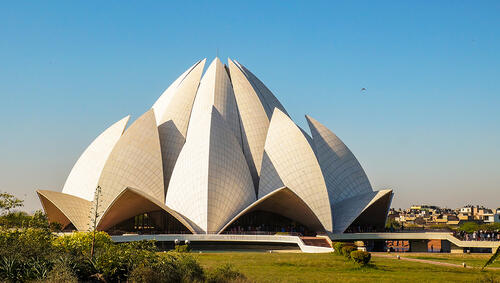
The award-winning Lotus Temple has been a crowd pleaser since it opened in 1986. This elegant Bahá'í place of worship features 27 petals, with trios forming a nine-sided flower. The marble was quarried in Greece and shaped in Italy before being shipped and assembled on site. The temple’s elegant design and graceful curves aim to accentuate soulfulness and spirituality. With a capacity for 2,500 people, the building has attracted visitors from all over the world, making it one of the most visited buildings in India. But it’s also a functioning place of worship where believers gather to hear the Bahá’í teachings.
Burj Khalifa, Dubai

There's a glut of cool buildings to pick from in the United Arab Emirates, but we'd be remiss if the tallest building in the world didn't make it onto this list. Burj Khalifa rises 828m meters into the sky above what was, until a relatively short time ago, untouched desert. It's been the world's tallest building since its completion in 2010, but it also holds six other accolades: the tallest freestanding structure, the highest number of stories (160), the highest occupied floor, the highest outdoor observation deck, the elevator with the longest travel distance and the tallest service elevator in the world.
Catedral Metropolitana Nossa Senhora Aparecida, Brasilia
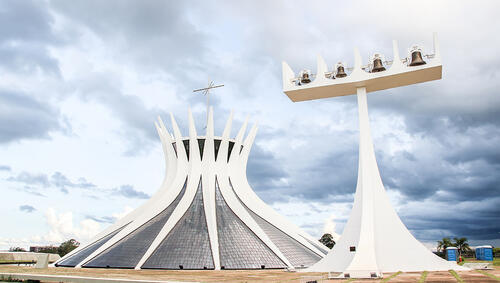
You don't have to look far in Brazil's capital city to stumble upon an example of acclaimed architect Oscar Niemeyer's work. When it comes to achingly good design, the hyperboloid format of his white cathedral sets the building apart. Sixteen concrete columns give the place its iconic shape and it's been featured in lists such as this since it topped out in 1970. Inside it’s just as jaw-dropping. Three angels suspended on steel cables, the largest measuring more than four meters long, hang in the nave. Above them, a stained glass window floods the space with blue, green, white and brown light.
Marina Bay Sands, Singapore

The 57th floor infinity pool that connects the top of the three towers of the Marina Bay Sands hotel is the world’s largest outdoor elevated body of water. As such, it was guaranteed to capture the world’s imagination when it was unveiled more than a decade ago. After all, who but the audaciously talented Singaporeans could even contemplate, let alone pull off, such a remarkable feat of engineering? This five-star resort hotel is just one of the anchor projects of the city’s Marina Bay area, sitting alongside the dazzling illuminated Supertrees of the Gardens of the Bay, the lotus-inspired ArtScience Museum and the Helix Bridge, inspired by human DNA.
Nur Alem Pavilion Sphere, Astana

The Nur Alem Pavilion Sphere bills itself as the largest spherical building in the world. It was constructed for EXPO-2017 and the ball was the focus of an evening laser light show. Its shape is said to depict the last drop of oil before green technologies usher in a new era. Today, it forms part of the Nur Alem Future Energy Museum, which incorporates interactive exhibits on themes such as space, the sun, wind, biomass, water and kinetic energy. The building practises what it preaches, boasting photovoltaic panels in its walls and integrated wind generators. The highest floor of the museum, eight stories up, doubles as an observation deck.

